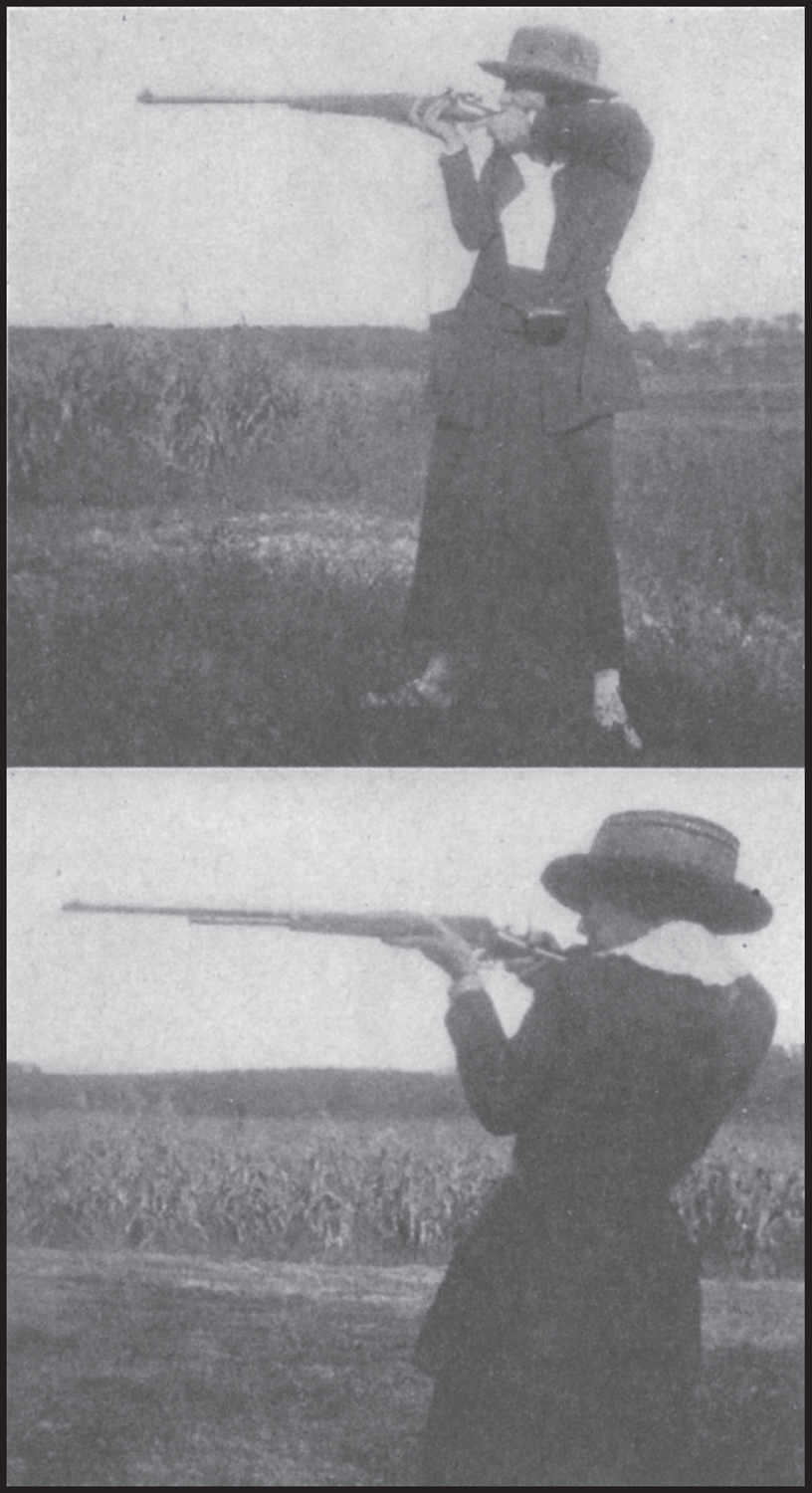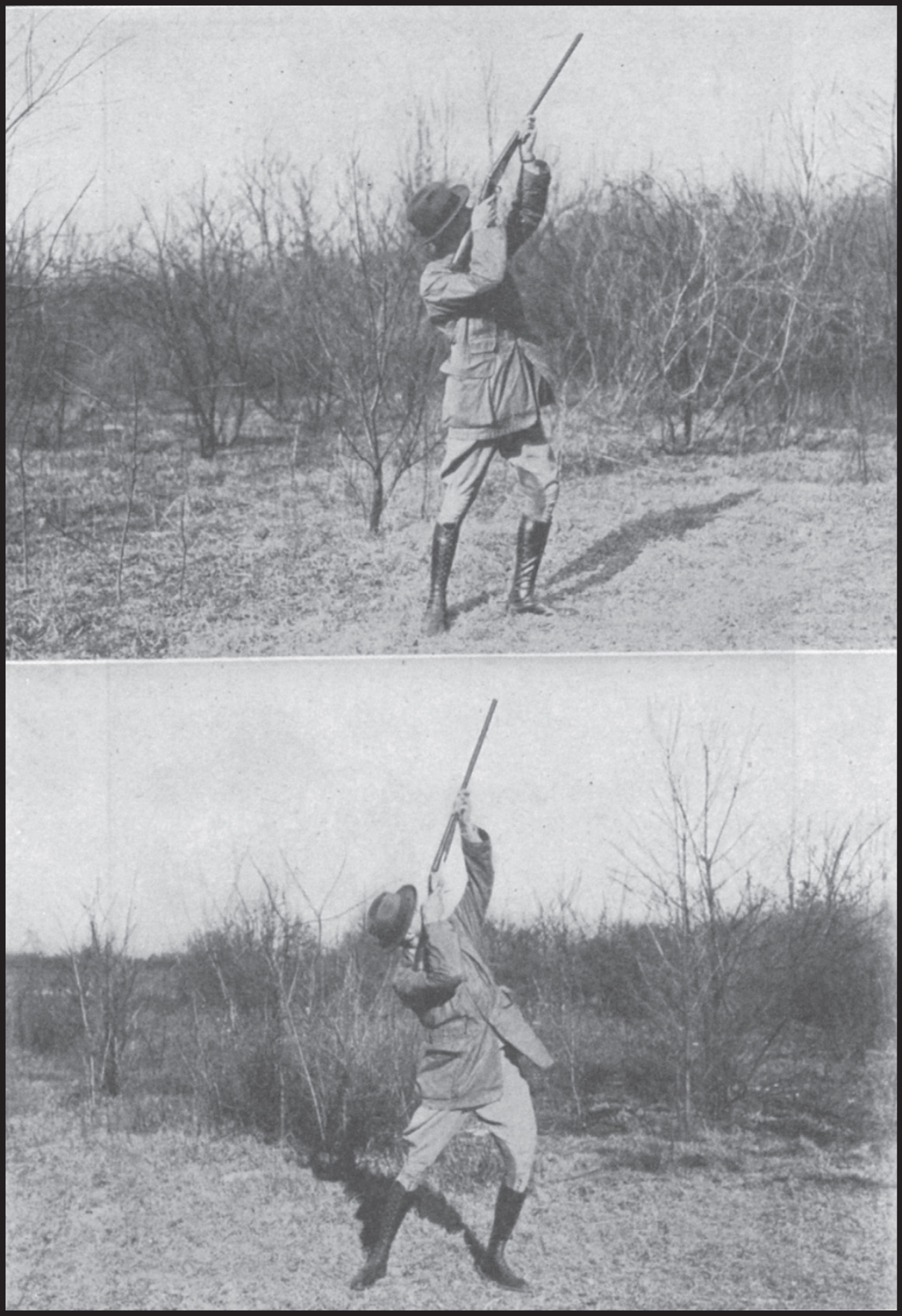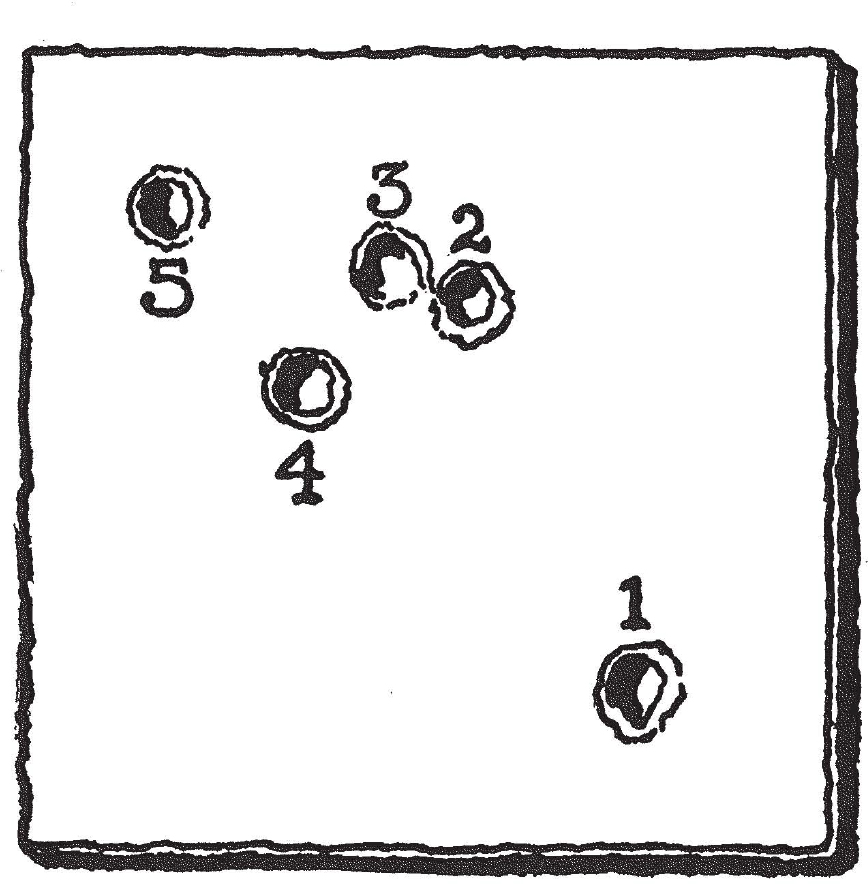
THERE are a lot of women afflicted with gun cranks for husbands who, in sheer desperation, would like to learn how to shoot. Yet most men scoff at the suggestion of teaching their wives, taking it for granted that they could not learn, or would surely kill themselves or some one else trying, while the woman, through a natural timidity regarding firearms and a lack of confidence in her own ability to become skilled at a game in which she is fully alive to her own ignorance, sits meekly back with folded hands and takes it for granted that she never could.
Generally speaking, they are both wrong. I have never had but one wife to teach, but I have instructed several other young women and have been surprised to find that, if they really want to learn and apply themselves to it, the normal young woman will learn fully as quickly as the average man who has never had any experience with firearms. To begin with, though highly strung, she generally has better control of her nerves, and her confidence increases with leaps and bounds when she realizes that, despite his greater strength, she can hold her own at this game with a man. Confidence has a great effect on the nerves and nerve control means everything in target shooting.
Of course, when it comes to hunting rifles, she has her limitations, particularly at long range work. You cannot expect her to go out with an eight and a half pound .45-70,—at least, few of them can do so. In the first place, it is too heavy for her to hold off-hand and it would kick the jaw off a small woman anyway, and if she lies down to shoot, the effect of the recoil is even more severe; but in the .22 calibre and the semi-high power small bore class she can hold her own.
The first step in her instruction is a .22 calibre rifle, beginning at 25 yards, with a large target on which all of the shots can be spotted, paying more attention to proper position, trigger squeeze and the safe handling of the weapon.
It is amazing how careless a beginner can be with a loaded gun, even though at heart she is still in deadly fear of it. Personally, I rather encourage a beginner to let off her rifle accidentally, taking care to be well behind the muzzle when it happens. It is an easy thing to make the patient do this by talking to her and attracting her attention while her finger is on the trigger (it is still easier with a man who is generally heavy handed) and when it goes off, give her a good lecture on what might have happened,—once is generally enough.

OFFHAND SHOOTING.
Upper—Perfect form. Left hand well back, elbow against side, right elbow high, body well balanced on both feet, eye close to sight.
Lower—Bad form. Body off balance, head bent over, and eye too far from sight.

TAKING AN INCOMER.
Upper—Good form. Body well balanced, left hand drawn back for better control of the muzzle, bird being taken at proper angle.
Lower—Poor form. Weight on left leg, body too far back, left hand too far forward, bird too far over.
Right here we are confronted with the problem of what rifle to buy for her that will be powerful enough for deer and have the other cardinal requisites of light weight, freedom from recoils and flat trajectory up to 300 yards.
The .25-20 H V and .32-20 H V are not nearly powerful enough. The .38-40 has too much recoil and the trajectory is too high, while all three (rapidly) lose accuracy beyond 100 yards, being as a rule incapable of better than 12 inch groups at 200 yards. And it should be remembered that the sportswoman will shine at standing shots at medium range rather than at quick running shots at short range which are much more apt to disconcert her. The .30-30 is a killer. The rifle is light and the trajectory flat; but, although on paper it has only 7.20 foot pounds recoil, it has a nasty way at times of bruising the shoulder and must consequently be overlooked for the beginner with the .303 and .32 Special. The .25-35 Winchester with its light recoil, only 3.39 foot pounds, and the muzzle velocity of 1,973 feet per second, compares very favorably with the .30-30, the velocity of which is only 2,023, while its recoil is more than double that of the .25-35. The striking force of the .30-30 is, of course, much higher, being 1,160.2 foot pounds at 100 yards against 749.6 foot pounds for the .25-35. However, the .38-40 high velocity which has only 771.9 foot pounds energy at the same distance has always been a very popular cartridge for deer. Add to this the advantage of a mid-range trajectory of only 5.69 inches at 200 yards and it is hard to beat as a powerful light weight rifle for a woman to begin with.
I selected the model 92 Winchester carbine for this cartridge, fitted with a Lyman Receiver peep sight to increase the sighting plane of the short barrel and a shotgun butt with a Silver’s recoil pad. This little gun, weighing 6½ pounds, is sufficiently powerful for game up to and including deer, and if she should have occasion to shoot at a heavier animal she is generally backed up by a guide with a more powerful weapon.
The smooth elegant lines of the Savage 1899 lends itself to a woman and I know of several who use it, but I am inclined to favor a gun with a big hammer for the novice rather than a hammerless. All of the automatics are too heavy to be considered.
After some experience has been gained with the .25-85 it is an easy step, if one prefers it, to the .250-8000. The recoil of 5.2 foot pounds should not be noticeable after considerable shooting has been done. But it is a good deal for her to handle to begin with.
In securing a weapon for this cartridge I would prefer the new bolt action Savage, Model 1920, if, as is likely after serving her apprenticeship, the sportswoman should aspire to larger game than whitetail deer and black bear, going forth in quest of moose, elk, or the larger species—it is only a slight expense to secure a new barrel and action for the .300 Savage cartridge. In a rifle of only six and a half pounds weight and a recoil of 11 pounds, generating a muzzle energy of 2,428 foot pounds, it is the ideal weapon for a woman to use for moose, etc. We must not lose track of the importance of light weight when a woman is to use it and the more powerful .30-06 Springfield invariably weighs a pound to a pound and a quarter more.
In my own case, or rather that of my wife, which was before the advent of the .300 cartridge, I jumped from the .25-35 to a Mannlicher-Shoenauer carbine, with an eighteen inch barrel, weighing six and a half pounds, and shooting the famous 6.5 mm. ammunition. This beautiful little weapon, because of its exquisite refinement of finish and superb balance and proportions, fitted with double set triggers, is certainly a serious contender for feminine favors,—particularly when we recall that in the hands of a noted sportswoman it accounted for a record elephant in British East Africa.
The 2-inch group shown was made by a woman who had started shooting but a month before with a .22 rifle and had never fired a shot with an intermediate calibre until this group was made with the .25-35 at 40 yards. The woman that could make such a target with five consecutive shots the first time she fired a high power rifle should be able to qualify on deer.
The question of a shotgun is more easily solved. The right weapon to begin with is a 20 gauge hammerless ejector of about 6½ pounds weight, with 28 inch barrels, right half choked and left full. It must be remembered that one cannot successfully shoot a small gauge gun with open bored barrels as the pattern will be too thin to be effectual and consequently, a beginner armed with a 20 is badly handicapped by a very close shooting gun. This, however, is really the less of two evils, as few women can stand the recoil of a twelve bore to begin with. Later, after some proficiency is gained, a sixteen bore can be adopted and that, to my mind, is the ideal weapon for a woman. The double is better than a repeater, as it is easier to operate and she can have the advantage of an open and a full choke barrel and be better prepared for all conditions.

Every one must work out his or her own problem at this game, but my advice is to teach her to shoot. It makes it easier to get away for a trip and to buy new guns, for she understands your feeling better. You may have an ammunition bill that will break the bank if she gets the fever (I did) but it’s worth all that and more too to keep her out in the air at the finest kind of exercise, and it will give you both many a happy day together at the targets which otherwise would have been dull and uninteresting.
After proficiency has been gained with the .22 calibre rifle on the fifty and seventy-five yard range, the next step is the .25-20. If taken slowly, there is little likelihood of developing a flinch, and this should by all means be avoided. A woman is delicately organized and if once a flinch is developed it may be necessary to begin all over again.
To digress a bit, after she learns, she is apt to be enthusiastic and insist on being taken along on the next hunting trip, and most old-timers will sit back with a knowing look and shake their sceptical heads at the proposal. Certainly I cannot advise; a man should be the best judge of his better-half’s capabilities (though often he is the worst). He should not expect a delicately reared girl to go out in the woods and work like a Siwash squaw and enjoy it; but there are adaptable young women that can be good sports and add considerable charm to a hunting expedition. There are lots of men that have killed their moose on several trips into the North woods, and to whom it is an old story which is growing stale, who could get a new pleasure out of it by coaching their wives through the summer, and seeing them get their trophy in the fall.